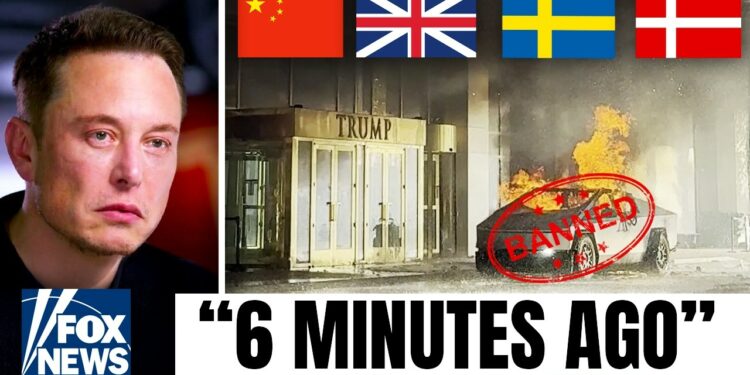The Cybertruck Controversy: When Innovation Meets Reality
The Tesla Cybertruck, once hailed as the future of automotive design, is facing a crisis that transcends mere technical issues. As frustration grows over Elon Musk’s political involvement, some are directing their anger at Tesla, with Cybertruck owners bearing the brunt of public backlash. Marketed as a 7,000-pound, bulletproof, stainless steel marvel, the Cybertruck promised to redefine transportation. However, its reality is far less glamorous: panels are detaching at highway speeds, global regulators are cracking down, and the vehicle has become a lightning rod for ideological battles. This is the story of a bold vision colliding with practical failures—and what it reveals about innovation, belief, and the cost of ambition.
A Symbol of the Future, Falling Apart
Introduced as a revolutionary machine, the Cybertruck’s sharp angles, exoskeleton design, and video game-inspired aesthetic captivated imaginations. Its 30X cold-rolled stainless steel, the same alloy used in SpaceX’s Starship, was marketed as indestructible. Yet, on March 20, 2025, the National Highway Traffic Safety Administration (NHTSA) issued a devastating recall for 46,096 Cybertrucks produced between November 2023 and February 2025. The issue? The cantrail trim, a stainless steel strip along the roof, is peeling off at highway speeds, posing a hazard to drivers and others on the road.
Shockingly, these panels were secured with adhesive—not mechanical fasteners—on a material designed to withstand 4,000°F re-entry temperatures. Tesla has pledged to replace the panels at no cost, but the financial toll is staggering, with estimates ranging from hundreds of millions to over $1 billion. This is the Cybertruck’s eighth recall, following issues like sticking accelerator pedals and erratic windshield wipers. The exoskeleton, the truck’s core identity, is literally coming undone, eroding Tesla’s brand in real time.
Global Rejection: A Design at Odds with the World
The Cybertruck’s woes extend beyond U.S. borders. In January 2025, Greater Manchester, UK, police impounded a Cybertruck for failing to meet basic safety standards, lacking a certificate of conformity. At over 2.2 meters wide and nearly 7,000 pounds, it requires a commercial C1 license in the UK—beyond a standard driver’s license. Its razor-sharp edges violate the UK’s 3.2mm rounding rule for vehicle exteriors, posing a risk to pedestrians. The full-width light bar, too bright and poorly positioned, blinds other drivers. Vandals in Manchester defaced a Cybertruck with profanity, reflecting growing public hostility.
Ireland’s narrow roads and Europe’s 3.5-ton limit for standard licenses make the Cybertruck impractical. Australia rejects its left-hand drive and rigid exoskeleton, which could turn collisions into deadly projectiles. China’s stringent pedestrian safety rules and pickup truck restrictions led Tesla to withdraw its filings in 2024. What America celebrates as innovation, much of the world views as reckless, effectively closing international markets to the Cybertruck.
A Polarizing Symbol in a Divided World
In the U.S., Cybertruck owners face vandalism—swastikas and profanity scrawled on their vehicles—tied to Musk’s role in Trump’s Department of Government Efficiency (DOGE). Allegations of Musk’s controversial behavior, including a denied claim of a Nazi salute at the inauguration, have turned the Cybertruck into a symbol of division. In New York, vandals have been arrested; in Europe, Tesla sales plummeted 59% in Germany and 12% in the UK in January 2025, with protesters targeting showrooms.
Public opinion is split. Some view the Cybertruck as bold progress; others see it as a dystopian, aggressive emblem of tech arrogance. Owners report harassment—flipped off on highways, angry notes left on windshields. Online, X discussions are so toxic that some owners use burner accounts to share experiences. The Cybertruck, once a status symbol, is now a battleground in an ideological war.
Financial Fallout and Brand Erosion
Tesla’s stock has plummeted 42% in 2025, erasing over $300 billion in market value. The recall of 46,096 Cybertrucks—more than the estimated 39,000 sold in 2024—is a logistical and reputational disaster. With global markets closed, Tesla must recoup its $1 billion+ Cybertruck investment from the U.S. alone. Musk’s divided attention across SpaceX, X, Neuralink, and DOGE raises governance concerns, prompting institutional investors to reduce their stakes.
Competitors like Ford’s F-150 Lightning and Rivian’s R1T are gaining ground, avoiding the Cybertruck’s regulatory and image issues. Skyrocketing battery mineral prices and supply chain challenges further strain Tesla’s cash reserves. Analysts are divided: optimists see a temporary setback, while pessimists view this as the first crack in Tesla’s dominance.
Engineering Ambition vs. Practical Reality
The Cybertruck’s 30X stainless steel exoskeleton is a marvel—strong, corrosion-resistant, and durable. Unlike traditional vehicles with lightweight panels over a frame, the exoskeleton is the frame, promising superior protection. However, its strength makes manufacturing a nightmare. The steel can’t be stamped, necessitating sharp angles and adhesives over welds. These adhesives, meant to endure heat, cold, vibration, and speed, are failing, exposing a critical oversight: Tesla prioritized innovation over proven engineering practices like mechanical fasteners.
Could Tesla redesign the Cybertruck for global compliance? Softening edges, reducing weight, and adjusting the light bar are feasible but would cost over $1 billion and dilute the truck’s identity. A rounded, conventional Cybertruck would blend into a crowded electric pickup market, losing its revolutionary appeal.
A Broader Lesson: Innovation vs. Regulation
The Cybertruck’s saga highlights the tension between unfettered ambition and regulatory guardrails honed over decades of automotive safety. It challenges assumptions about vehicle design, performance, and who sets the rules. Tesla faces three paths:
- Double down: Focus on the U.S. market with minimal changes to meet recall requirements.
- Redesign: Invest billions in a globally compliant version, sacrificing the Cybertruck’s essence.
- Sunset: Phase out the project, treating it as a bold but flawed experiment.
Beyond the Truck: A Turning Point
The Cybertruck is more than a vehicle—it’s a manifesto of American exceptionalism and technological ambition. Its bulletproof shell and angular design, once symbols of progress, now evoke excess and fragility. Is it a misunderstood marvel crushed by bureaucracy, or a reckless project prioritizing shock over safety? The truth lies in the collision of vision and reality.
This moment transcends automotive debates, reflecting broader tensions: innovation versus regulation, myth versus reality, and ambition versus execution. The Cybertruck’s unraveling is a reminder that the future is engineered, tested, and sometimes undone. As Tesla navigates this crisis, the patterns—missed by most—reveal what’s at stake: not just a truck, but the systems shaping technology, power, and progress in the modern world.
























